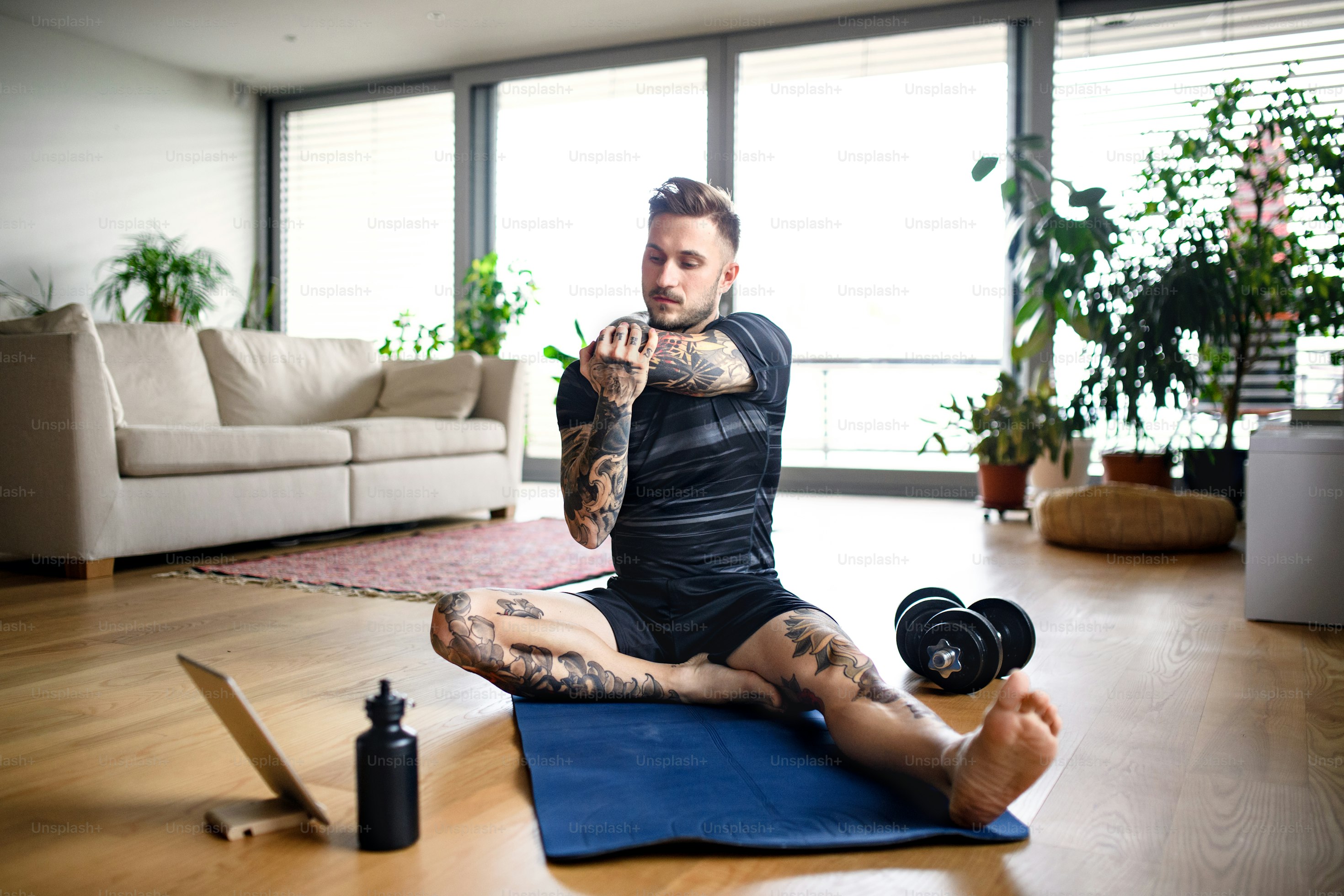Table of Contents
The Foundation of Tailored Fitness
In the whirlwind of our daily lives, balancing work, family, and personal commitments often leaves little room for regular visits to the gym. Yet, the desire for a healthier lifestyle persists. Enter the concept of “Fitness at Home,” a beacon of hope for those seeking a sustainable workout regimen within the comforting confines of their abode.
Embarking on a fitness journey at home isn’t merely about physical exercise; it’s a mindful commitment to self-care. It’s about creating a personalized routine that seamlessly integrates with your daily schedule, amplifying both your physical and mental well-being. Join me on this quest to design a fitness routine that harmonizes with your lifestyle, promoting health and vitality.
Shall we delve into the foundational steps of assessing your schedule to carve out dedicated fitness moments amidst life’s hustle and bustle? Let’s navigate through this transformative journey together.
Assessing Your Schedule: Unearthing Your Time Slots
Before diving headfirst into crafting your fitness sanctuary, take a moment to map out your daily agenda. Unearth the pockets of time within your schedule that can be devoted to your fitness escapades. Whether it’s the tranquility of the early morning, the brief respite during lunch hour, or the evening wind-down, identify these golden hours.
Understanding your commitments allows for realistic planning, ensuring your fitness routine seamlessly integrates into your lifestyle. Recognize these time slots as sacred moments for nurturing your physical and mental health. Once you’ve mapped your schedule, let’s move on to crafting your ideal workout space at home.
Designing Your Home Workout Space: Creating Your Fitness Sanctuary
Picture this: a dedicated corner or room within your abode transformed into a fitness haven, beckoning you to embark on your wellness journey each day. Designing your home workout space is pivotal in cultivating an environment conducive to exercise, motivation, and focus.

Creating a Conducive Environment
Begin by selecting an area in your home that resonates with your workout aspirations. It could be a spare room, a corner of the living room, or even the outdoors if weather permits. Ensure ample ventilation, natural light, and a clutter-free ambiance to ignite your motivation.
Personalize the space with motivational posters, vibrant colors, or elements that inspire and energize you. This personalized touch serves as a visual catalyst, igniting your passion for fitness every time you step into this sacred space.
Essential Equipment and Setup Tips
You don’t need a vast array of sophisticated equipment to kickstart your fitness journey at home. Start with the basics: a yoga mat, resistance bands, dumbbells, or even household items like water bottles or chairs for exercises. These versatile tools cater to a myriad of workouts without occupying excessive space.
Strategic storage solutions, such as shelves, baskets, or wall-mounted racks, keep your equipment organized and easily accessible. This minimizes clutter, allowing seamless transitions between exercises and enhancing your overall workout experience.
A well-ventilated and adequately lit space coupled with minimal distractions sets the stage for an invigorating workout session. Now that your workout space is primed, let’s move on to crafting a personalized workout plan tailored to your preferences and goals.
Crafting Your Personalized Workout Plan: Tailoring Fitness to Your Goals
Welcome to the heart of your fitness journey – crafting a workout plan that aligns with your goals, preferences, and schedule. Your personalized routine should encompass a blend of exercises that not only challenge your body but also resonate with your interests and aspirations.
Types of Exercises Suitable for Home Workouts
Embrace diversity in your workout regimen by incorporating various exercise modalities. Bodyweight exercises like squats, push-ups, and planks require minimal equipment and offer excellent results. Add in cardio exercises such as jumping jacks, skipping rope, or dancing to elevate your heart rate and torch calories.
Furthermore, consider incorporating yoga or Pilates for flexibility, balance, and mental relaxation. These exercises not only strengthen your body but also promote mindfulness and tranquility.
Structuring a Balanced Routine
Balance is key in designing an effective workout plan. Allocate time for different types of exercises – cardio, strength training, flexibility, and restorative practices. Aim for a blend that challenges different muscle groups while allowing adequate recovery periods.
Strategically divide your workout week into segments focusing on specific areas or goals, such as upper body, lower body, core strengthening, or endurance training. This division ensures a holistic approach to fitness, preventing monotony and overexertion.

Time-Saving Techniques for Effective Workouts: Maximizing Efficiency
In our fast-paced lives, time often feels like a precious commodity. When it comes to fitness, optimizing the time spent on workouts can be a game-changer. Incorporating efficient techniques ensures that even the briefest workout sessions pack a punch.
Strategies to Maximize Workout Efficiency
- HIIT (High-Intensity Interval Training): Embrace the power of HIIT workouts, alternating between short bursts of intense activity and brief recovery periods. This method elevates your heart rate, torches calories, and continues to burn fat even after the workout ends.
- Compound Exercises: Opt for compound movements that engage multiple muscle groups simultaneously. Exercises like squats with overhead presses or lunges with bicep curls maximize efficiency by targeting multiple areas at once.
- Circuit Training: Design a circuit comprising various exercises performed in succession with minimal rest in between. This approach enhances cardiovascular fitness while building strength and endurance.
- Focused Workouts: Devote focused, shorter workouts to specific body parts or goals. For instance, a 20-minute core blast or a quick, targeted arm workout can be remarkably effective.
Incorporating High-Intensity Intervals
HIIT sessions, known for their brevity and intensity, offer a remarkable fitness punch within a short timeframe. A typical HIIT workout might involve 30 seconds of all-out effort followed by 30-60 seconds of rest or lower-intensity activity. These intervals can be tailored to match your fitness level and gradually increased as you progress.
The beauty of these time-saving techniques lies in their adaptability to various schedules. Whether you have 10 minutes or an hour, these strategies ensure that every moment dedicated to fitness yields significant results.
Adapting to Changing Schedules: Sustaining Consistency Amidst Life’s Flux
Life is a dynamic tapestry woven with unexpected twists and turns. Adapting your fitness routine to accommodate these fluctuations is the key to sustaining consistency in your journey towards better health.
Flexibility in Routine Adjustments
Embrace adaptability as the cornerstone of your fitness journey. Life’s demands might disrupt your meticulously crafted schedule, and that’s perfectly normal. Instead of viewing these disruptions as obstacles, consider them as opportunities to recalibrate your routine.
Be flexible in adjusting workout timings or types of exercises to accommodate changing schedules. If a morning routine is disrupted, seize the evening or break your workout into smaller segments throughout the day. If you’re looking to establish a routine but aren’t sure where to start, consider visiting this Sunday reset routine. It can provide you with ideas on how to adapt those tips to improve your overall well-being.
Maintaining Consistency Amidst Changes
Consistency doesn’t always mean rigid adherence to a fixed routine; it’s about staying committed to your fitness goals despite the flux. Set realistic expectations and be forgiving of yourself during challenging times.
Establish a backup plan for busy days or unforeseen circumstances. Short, intense workouts or quick mindfulness sessions can serve as a buffer during chaotic periods.
By embracing adaptability and maintaining a resilient mindset, you’ll navigate through life’s ebbs and flows while keeping your fitness flame burning bright
Motivation and Accountability: Sustaining the Fitness Flame
In the realm of fitness, motivation acts as a guiding beacon, steering us through the highs and lows of our journey. Finding ways to stay motivated during home workouts is crucial for consistent progress.

Staying Motivated During Home Workouts
- Set Clear Goals: Define specific, attainable fitness goals. Whether it’s improving endurance, losing weight, or mastering a particular exercise, clear objectives serve as motivation milestones.
- Variety is the Spice: Infuse diversity into your routine. Experiment with different exercises, workout formats, or even fitness challenges. Novelty sparks excitement and keeps boredom at bay. One of the most famous fitness challenge was Chloe Ting’s Hourglass Challenge. I started her work out routine and I could visibly notice the difference in my physique just in 7 days.
- Accountability Partners: Enlist a workout buddy or join virtual fitness communities for support and camaraderie. Sharing your journey with others fosters a sense of accountability and motivation.
- Celebrate Small Wins: Acknowledge and celebrate every achievement, no matter how small. Progress, irrespective of size, is a testament to your dedication and deserves recognition.
Establishing Accountability Measures
Hold yourself accountable by creating a structured framework for your fitness journey. This could include:
- Setting Reminders: Use apps or alarms to prompt workout sessions, ensuring you stick to your schedule.
- Tracking Progress: Keep a workout journal or use fitness apps to monitor progress. Seeing tangible improvements can be a powerful motivator.
By intertwining motivation and accountability, you’ll forge a resilient mindset that propels you toward your fitness aspirations. As we move closer to the conclusion of our fitness journey, let’s explore the significance of tracking progress and celebrating milestones.
Tracking Progress and Celebrating Milestones: Markers of Achievement
- Importance of Monitoring Progress: Tracking your fitness journey isn’t just about numbers on a scale or repetitions in a workout. It’s about understanding your growth, identifying patterns, and celebrating the gradual transformations—be it increased stamina, improved flexibility, or enhanced mood and energy levels.
- Tracking Tools and Methods: Utilize fitness apps, journals, or wearable devices to monitor your progress. Log workouts, measurements, and how you feel after each session. This data provides valuable insights into your evolution.
- Celebrate Every Achievement: Every milestone, no matter how small, deserves recognition. Celebrate reaching new workout benchmarks, overcoming plateaus, or even sticking to your routine during challenging times. These celebrations fuel your motivation and reinforce your commitment to a healthier lifestyle.
Remember, the journey to fitness is not just about the destination; it’s about relishing every step and celebrating the milestones along the way.
Let’s address some commonly asked questions that might provide further clarity and guidance on building a fitness routine that harmonizes with your schedule and goals.
Frequently Asked Questions (FAQs) on Fitness at Home:
1. How can I find time for workouts in a busy schedule?
Finding time for workouts amidst a packed schedule involves prioritization. Identify pockets of time, even if it’s just 15-20 minutes, and dedicate those moments to exercise. Break workouts into shorter sessions or incorporate physical activity into daily tasks, like taking the stairs or going for brisk walks during breaks.
2. What are some effective exercises for home workouts without equipment?
Bodyweight exercises like squats, lunges, push-ups, and planks are incredibly effective. Additionally, activities such as yoga, Pilates, and HIIT workouts require minimal or no equipment and yield excellent results.
3. How do I stay motivated when working out alone at home?
Setting clear goals, diversifying your routine, and seeking support through virtual fitness communities or workout buddies can keep motivation levels high. Celebrate milestones and remind yourself of the progress made to stay motivated.
4. What if my schedule changes frequently? How can I maintain a consistent fitness routine?
Flexibility is key. Adapt your workouts to fit into the available time slots. Have a backup plan for busy days and aim for consistency rather than perfection. Shorter, intense workouts or incorporating physical activity into your daily routine can help maintain consistency.
5. How important is rest and recovery in a home workout routine?
Rest and recovery are integral parts of any fitness regimen. Ensure adequate rest days between intense workouts to allow your body to recover and repair. Listen to your body and prioritize sleep, hydration, and proper nutrition for optimal recovery.






